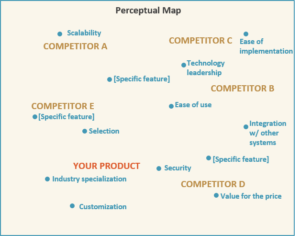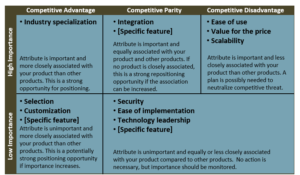B2B Product Positioning: A Powerful Strategy in Three Steps
Research recently conducted by the Corporate Executive Board found that 86% of B2B buyers usually don’t see a difference between suppliers that is worth paying for. As a result, B2B suppliers increasingly find themselves competing on little else but price. To remedy this, B2B marketers must get better at brand and product positioning to differentiate themselves from competitors in a way that their customers truly value.
Let’s get one important matter out of the way first. Positioning is not something you do to your brand or product. Positioning is something you do to the mind of your target customer with your brand or product (and your message). In other words, your brand or product holds a certain position in a person’s mind – or a perception – and positioning is the act of either reinforcing that perception or trying to change it.
To ensure that this perception customers have of you works to your advantage and causes them to favor you, it needs to have three key characteristics.
1. Uniqueness
This is the heart of positioning. You need to stand for something unique and your target customers need to perceive it as being substantially different than what they encounter with your competitors.
2. Importance
Just being different is not enough. This difference also must be meaningful and relevant to the customer. If it’s not, it’s unlikely to motivate them.
3. Credibility
You may be able to satisfy the first two criteria above, but if your positioning isn’t believable, it will all fall apart. Before making any positioning claims in your marketing, ask yourself questions such as these:
• Do we have evidence to support this claim? (The more objective the evidence, the better.)
• Can we consistently deliver on this claim?
• Is there an indication that customers believe the claim and that we can deliver?
How do you get a clear view of this mental impression your target customers have of you? How do you know what’s most important to your customers? How do you determine if they’re “buying what you’re selling”? You guessed it. You ask them.
There is a variety of customer research that can be carried out to provide the foundation for positioning strategy. I will briefly describe a three-step process I find to be the most effective way to gain the insights you need.
Step 1
Your target customers who are familiar with your company already have a mental picture of you and many of your competitors. Your first task is to figure out what this current state is and if you satisfy the first criterion of being unique. Building a perceptual map like the one shown below is a great way to do this.

This map is created by asking survey respondents to rate how you and your competitors perform in a number of attributes. Then a bit of statistical magic is performed on the data (correspondence analysis) to depict in a virtual space how customers as a whole visualize you and your competitors in terms of perceived similarities and differences. (Note: In the map above, “specific feature” is a placeholder for features specific to your product category.)
Step 2
After gaining this understanding of perceived distinctiveness, the next step is to find out how important these differences are to your target audience. You could of course ask them directly, but the tendency for many people is to say that a lot of things are important. Instead, we can reach back into our statistical bag of tricks to find regression analysis, a technique that derives the importance of attributes by deciphering the extent to which each attribute drives the overall perception people have about a brand or product.
Step 3
The two previous analyses can then be combined into a single matrix like the one shown below.

This matrix summarizes the critical insights about customer perceptions that you can leverage to devise your positioning strategy. Here are some recommended ways to put this knowledge into action:
1. Positioning – As mentioned above, this process will help you get a clear snapshot of the mind of the customer and the position you currently hold there, giving you an excellent foundation from which to decide whether to reinforce the current state or attempt to reposition (see next item).
2. Repositioning – This analysis may uncover new and stronger positions for you to consider that would allow you to improve your ability to stand out and compete.
3. Competitive Intelligence – This research can be a valuable input to a strategy you are developing to step up the fight against a specific competitor.
4. New Products – This exercise can also be very useful in your new product planning by helping you identify a gap in which no product exists or meets needs and thus represents an opportunity to create a solution (or modify your current one) to fill it.
There are a few additional things to keep in mind:
First, you still need to account for the credibility of your positioning. This mainly comes into play when attempting to change or create a new position. Assessing believability is very straightforward. You can simply ask your target audience to rate the believability of your claim and indicate if they have any problem associating it with your company.
Second, the reality for many B2B suppliers is that they have a team of people buying their solutions, not just one person. In this case, the optimal approach is to develop a positioning strategy for each key stakeholder role. Or, at the very least, you’ll want to address the champion or mobilizer who is likely to be your strongest proponent within the customer company. (Market research can also help you determine who is who.)
Last, but not least, after you begin implementing your positioning strategy, you will want to track your progress by periodically recreating the perceptual map. Don’t forget that your competitors won’t be standing still either, so it’s important to keep a close eye on their changes as well.
To learn more about how Inquisitive will help you gain the positioning insights you need, visit our page here Positioning & Messaging Research, or contact us.


